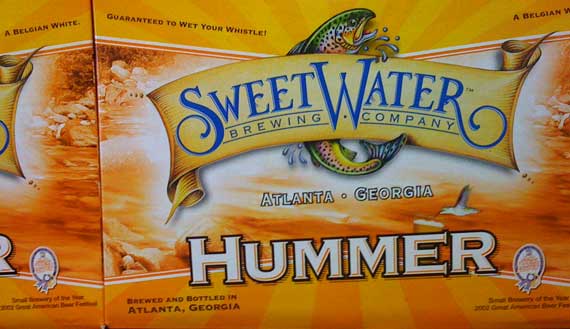Musings
Biodiversity—the variety of all life, from genes and species to ecosystems—is intimately linked to Earth’s climate and, inevitably, to climate change. Biodiversity and poverty are also inextricably connected. For instance, changes to natural ecosystems influence both climate change and people’s ability to cope with some of its damaging impacts. And in their turn climate change, as well as people’s responses to it, affect biodiversity. Unpicking all these strands clearly shows that conserving and managing biodiversity can help natural systems and vulnerable people cope with a shifting global climate.
Is this assertion by Hannah Reid and Krystyna Swiderska in the abstract of a paper for the International Institute for Environment and Development (IIED) correct? Certainly, the first instinct is to say yes.
But.
Let’s start with biodiversity: it is not fixed, but instead something that has always fluctuated, both through time and across space. The assortment of species we see today and their home ranges have no special or sacred qualities—in fact, they were different five hundred years ago, ten thousand years ago, etc. (let alone, say, thirty million years ago).
So, yes, among the many factors that influence biodiversity, climate is one.
Here’s where I start to struggle: “people’s ability to cope with some of its damaging impacts”…. Climate change is both damaging and enhancing, because those words evidence judgemental perspectives. “Damaging” assumes any change is only negative. Not so.
You sorta have consider the history of the human species as a long, complex trail of significant human-induced landscape change (maybe more of a spreading blotch). These alterations accelerated with the shift away from subsistence that was exclusively from gathering and hunting, and with concomitant demographic increases. Duh. The flip side of all this is that humans are around in such numbers as we see today because we are good at this adaptation stuff, aka coping. But. [Hope I don’t come off as flip.]
It is virtually impossible to prioritize preserving biodiversity as the most important or wisest goal in our reaction to climate change. It may be a wise goal to promote the preservation of biodiversity as leverage to induce people to be more responsible about impacts on the environment within their control, but otherwise the argument evinces more rhetoric than logic.
Posted at 5:16 PM |
Comments Off on Hummin’ humans
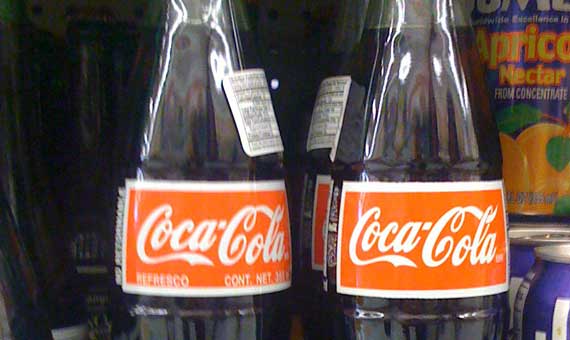
These are approximately 12-ounce bottles….
You know this: the Co-Cola you get in the US is sweetened with (the nasty) HFCS*. Indeed, I think the whole New Coke maneuver was about switching US consumers to a dark liquid called Coke, but no longer tasting “right”, because it was no longer sweetened with sugar (aka sucrose)—the kind from cane or beets. When the dust had settled, the US market had been switched to a new cheaper Coke—that is, made with cheaper ingredients—yet sold at the same old price!
Suckers!
However. Even here in ATL (home of Coke), if you know the drill, you can get Coke made with sugar. Here’s how: go to a Latin market, or even the Latin section of the international aisle of your neighborhood Kro-gah (shown above), and, voila!, there it is, in a real glass bottle, with a paint job in Spanish, and a US nutrition sticker.
And the real twist (other than what this shipping does to the carbon footprint)? The price. $1.79. Plus tax.
* HFCS = high fructose corn syrup
Posted at 4:08 PM |
Comments Off on Inside story

I’ll just slip this onto the server before the storm front arrives. That old saying “April showers bring May flowers” just doesn’t match this latitude….
Okay, for fun, where do you fit on the generational timeline? Are you brownish, beige-ish, or blue? Or that other greenish shade?
Posted at 4:11 PM |
4 Comments »
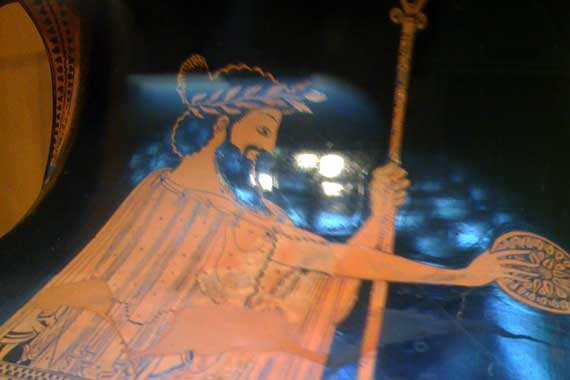
Over at the High on Val’s Day I learned a new word— oinochoe, sometimes spelled oenochoe.
I knew krater (sometimes crater; Greek*: κεράννυμι)—those are the big vase-shaped vessels (sorta) with vertical sides and big open mouths (usually), with paintings on those straight sides (the art museum versions, anyway).
What I hadn’t retained was how kraters were used: they’re the Greek version of wine party-kegs. That’s where the wine was cut with some water, then the liquid was dipped out for the partiers. I guess kraters were probably important and central to the party scene, somewhat like a huge functional floral arrangement….
The oinochoe (Greek*: οινοχόη) was another part of the wine-party ritual and ceramic assemblage. It’s a smaller jug used to transport watered wine from the krater to the partiers. It has a curvier shape than the krater, and the examples I saw also had painted scenes on the shoulders and bulbous sides, and sometimes were decorated near the rims, too.
Anyway, the big take-home message here is that the Greeks (the haves, anyway) were big into the party scene complete with an assemblage of wine vessels, both decorative and functional. The partying was for more than simple pleasure (whoopee!). The various vessels also were placed in burials, so wine-feasts were linked not only to religious rituals but to funerary activities, too…. In a sense, this connection to wine undergirded the ancient Greeks’ sense of self and cultural identity, and they shipped wine to their colonies so they could continue to, well, be Greeks.
A corollary is that in the art museum setting, lovely archaeological artifacts lack their context (there I go again!), and are, for the most part, reduced to being just objects. Pretty, sometimes. Interesting, sometimes. But soulless. Spot-lit for aesthetics and little more….
* Greek translations are from Wikipedia….
Posted at 6:03 PM |
Comments Off on Krater vs Oinochoe

Except for the pixellation, perhaps this could have been in the exhibition we saw yesterday…but it’s grabbed from Google Earth, and is of the Iranian coast just west of the Strait of Hormuz, tipped for a low-angle view….
In June the U.P. is a semitropical bug farm.
That’s Jim Harrison in Returning to Earth (2007; pg. 78), and he’s so right! Although not always—he also says the Seney stretch is 50 miles, but I think it’s quite a bit less. Like high 20s. I guess if you’re on a bicycle, though, it may well feel like fifty miles!
You may know Harrison as the author of Legends of the Fall or Wolf (both made into movies), or possibly from his non-fiction writing about food and cooking. I cleave more to his fiction pieces set in Michigan or Oklahoma.
Today’s vocabulary: cleave
Interesting word meaning either to split/sever or to adhere (both verbs, notice). Opposite meanings…I meant the latter…. I guess the clue is the “cleave to” phrasing; with “to” cleave almost always means to adhere/be attached.
Posted at 1:19 PM |
6 Comments »

Distinctive ceiling of quarter-circle Robinson Atrium….

Sunny day…so we ducked our responsibilities and went over to the High Museum to see the Stieglitz women exhibition, which was very interesting indeed, although I would have been happy to see about four times as many pieces. I loved seeing pictures of the artists themselves—including of course Georgia O’Keefe—as it gives ever so much context (and we all know how archaeologists obsess over context!).
The atrium space is one of an iconic architectural detail (?), hence the photo above. But I also had to include a teeny sample of the art of the Stieglitz women….
JCB and I had a wee chat about photography then and now—now meaning digital. However many pictures you’ve taken lately, how much did you think about the vagaries of printing? That’s a whole set of variables I can ignore as a casual photographer….
Posted at 5:18 PM |
1 Comment »
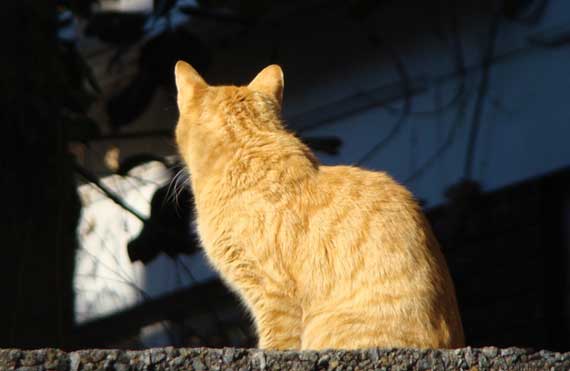
Look at those whiskers!
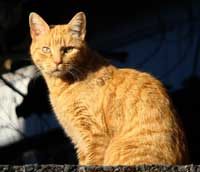
Yeah, at the Westminster Kennel Club Dog Show the judge picked a cutie-beagle for best in show.
My pet-snapshot is a lovely ginger cat I found sitting in the sun (the other day, I admit; today is not this nice—in fact it’s windy and cold—brrrrrrrrr!)—but looking away. In fact, apparently concentrating on looking away…the way cats sometimes do….
Finally, I did my best to emit a purring sound. The cat turned—and I got the money shot….
Science note
The ginger coat-color is a sex-linked trait; ginger cats are most often male. On the other hand, cats with tortiseshell or calico coats are almost always female.
Read the Wikipedia discussion of this—and much more—on cats….
Posted at 6:09 PM |
3 Comments »

I don’t know enough Photoshop to color-correct this to a tad more greenish….
Due to fluishness incubating elsewhere, the cake-and-candles RHB 82nd celebration has been postponed until Friday—although maybe without the candles. In recognition of the actual day, we took over a beeg pot of split pea soup for leetle lunch….
If menus influence the weather, then the wintery pea soup may be the reason it’s supposed to get a bit nippy around here overnight and tomorrow—well, if you call high in the mid-40s nippy….
Posted at 6:10 PM |
Comments Off on Beeg soup!

Photo thanks to JCB….
We spotted a pair of these flitting about under a large spreading oak this weekend. I thought it was an Eastern Bluebird (Sialia sialis), and, voila!, a bit of image-googling, and it’s confirmed!
Isn’t it good luck to spot a bluebird?
Posted at 5:42 PM |
Comments Off on Urban birding

Who screwed up the handrail?
So, you’re at the park with your buddies. You’ve all got your roller blades on. What’s next?
Posted at 10:22 PM |
Comments Off on Balancing act
